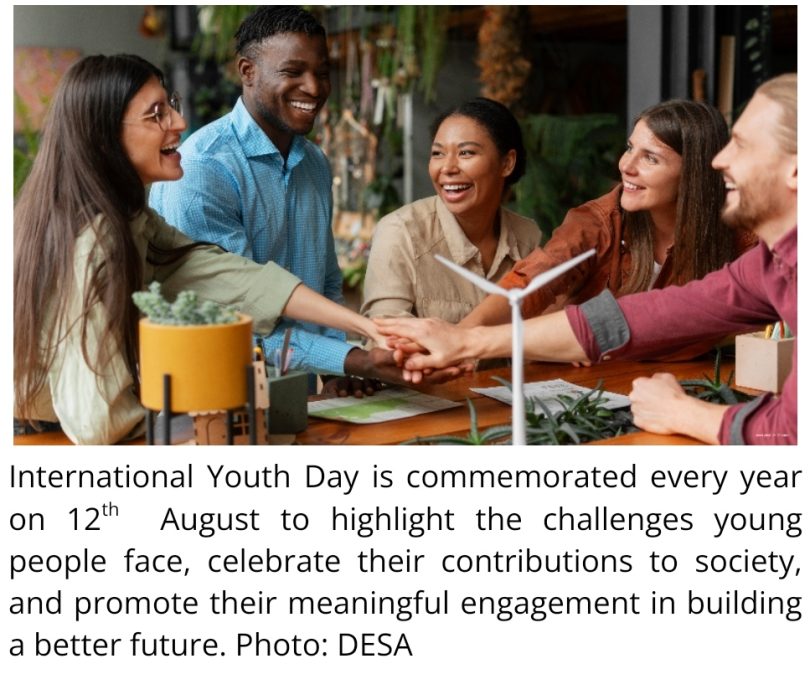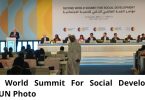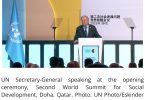As the 2030 deadline for the Sustainable Development Goals draws closer, the 2025 International Youth Day places the spotlight on local action and youth leadership. This year’s observance, anchored in Nairobi, speaks on how young people are reshaping governance and driving change from the ground up.
The 2025 International Youth Day (IYD) theme, “Local Youth Actions for the SDGs and Beyond,” reflects a shift in the role of young people in achieving the SDGs, one that has become increasingly visible and valuable. While the SDGs are a shared global vision, their implementation depends largely on how effectively they can be adapted to local realities.
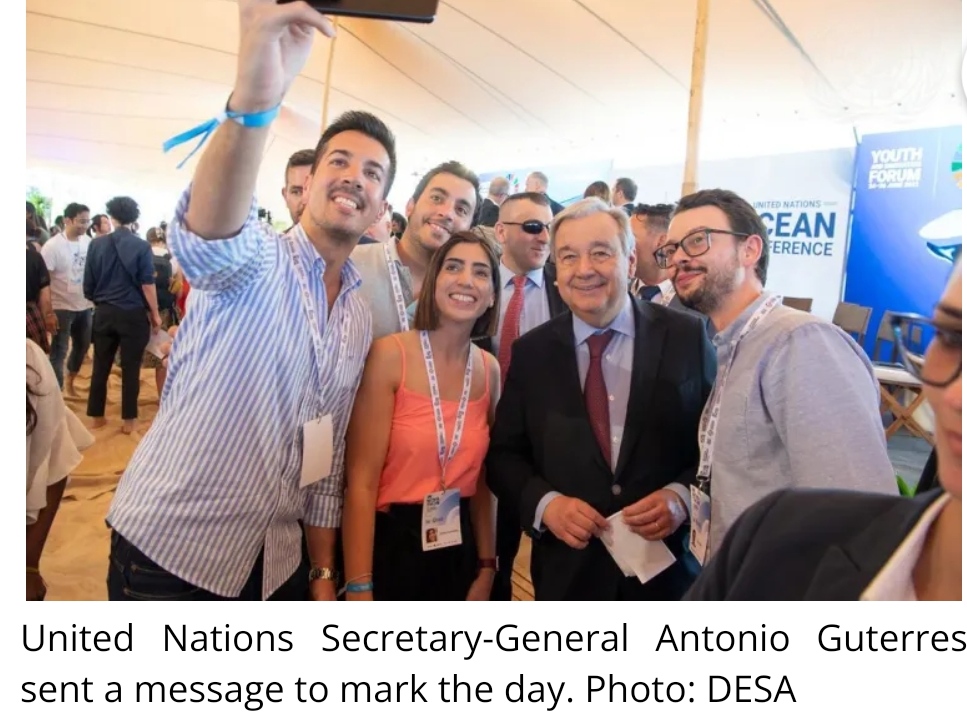
With more than 65% of the SDG targets linked to local governance, youth engagement is not simply beneficial but is also integral. Young people bring fresh perspectives, strong community ties, and a willingness to explore new solutions. These qualities position them to help bridge the gap between high-level policy and day-to-day practice.
This year’s observance carries additional significance as it coincides with the 30th anniversary of the World Program of Action for Youth, a framework that has guided policy for recognizing and supporting young people as partners in development. The anniversary offers an opportunity not just to reflect on progress, but to consider how the principles of youth inclusion can be further embedded in governance at all levels.

The official 2025 IYD commemoration will take place on August 12 in Nairobi, Kenya, in collaboration with UN-Habitat. The event will convene youth leaders, local government officials, policymakers, and development practitioners to share practical approaches for strengthening youth participation in local decision-making. The aim is to connect ideas with workable models that can be applied across different contexts.
Beyond the official gathering, the UN encourages communities worldwide to mark the day with activities that foster dialogue and collaboration. These range from educational radio programs and youth forums to exhibitions, cultural events, and public debates. Each initiative, whether large or small, reinforces the principle that meaningful youth engagement thrives where it is supported and encouraged locally.
UN Secretary-General António Guterres summarized the spirit of the day in his annual message: “Global progress begins in communities. Young people are bold innovators, resilient organizers, and essential partners in achieving the Sustainable Development Goals. When young people lead, societies thrive.”
Building Long-Term Foundations for Youth Leadership
Globally, there are 1.2 billion people aged 15 to 24, about 16% of the population. This figure is projected to reach nearly 1.3 billion by 2030. This growing demographic brings both potential and responsibility. Young people are active in advancing education (SDG 4), shaping economic opportunities (SDG 8), and addressing climate change (SDG 13), often in ways that directly benefit their communities.
International Youth Day 2025 is an occasion to highlight these contributions and to support their expansion. Strengthening the role of youth in local governance requires consistent investment and funding for youth-led initiatives, capacity-building program, and mechanisms that ensure their perspectives are integrated into planning and policy. Local and regional governments, with their close connection to communities, have a unique ability to create environments in which young people can apply their skills and ideas effectively.
Rather than a single day of recognition, the value of IYD lies in its potential to reinforce an ongoing commitment: enabling youth to work alongside institutions, not on the margins of them. By doing so, communities stand to gain leaders who are well-prepared to navigate the complex challenges of sustainable development today and beyond 2030.
Beyond Celebration, Practical Action
While International Youth Day is a moment of global recognition, it is also a call to practical action at the community level. Young people, civil society groups, and local institutions are encouraged to mark the occasion in ways that spark dialogue, build understanding, and foster change.
Possible activities include:
- Hosting educational radio program with community leaders and youth voices.
- Organizing debates or forums on youth contributions to global challenges.
- Facilitating intergenerational discussions to bridge perspectives.
- Curating art exhibitions that reflect youth experiences and aspirations.
- Partnering with local media, schools, and universities to amplify the message.
These initiatives not only spread awareness but also give young people a direct role in shaping narratives and policies that affect their lives.
Youth as Drivers of the SDGs
The 2030 Agenda’s pledge to “leave no one behind” is inherently inclusive of youth. Young people are specifically referenced in the Goals relating to employment, education, gender equality, and the promotion of peace.
Key areas include:
- SDG 4 – Quality Education: Access to equitable and relevant education is critical for youth transition into the labor market and civic life.
- SDG 8 – Decent Work and Economic Growth: Addressing youth unemployment and underemployment is essential for sustainable economic progress.
- SDG 13 – Climate Action: Young people are leading climate movements, innovating solutions, and holding leaders accountable for environmental commitments.
Young people have been central to the design, monitoring, and implementation of the 2030 Agenda. They are active in grassroots movements, data collection, policy advocacy, and shadow reporting, ensuring that progress is measured not just in numbers but in impact on lives.

Their work in local contexts often catalyzes broader change. Whether advocating for clean energy in rural communities, creating start-ups to tackle food insecurity, or leading digital campaigns for social justice, youth-led initiatives demonstrate that transformative change is rooted in local realities.
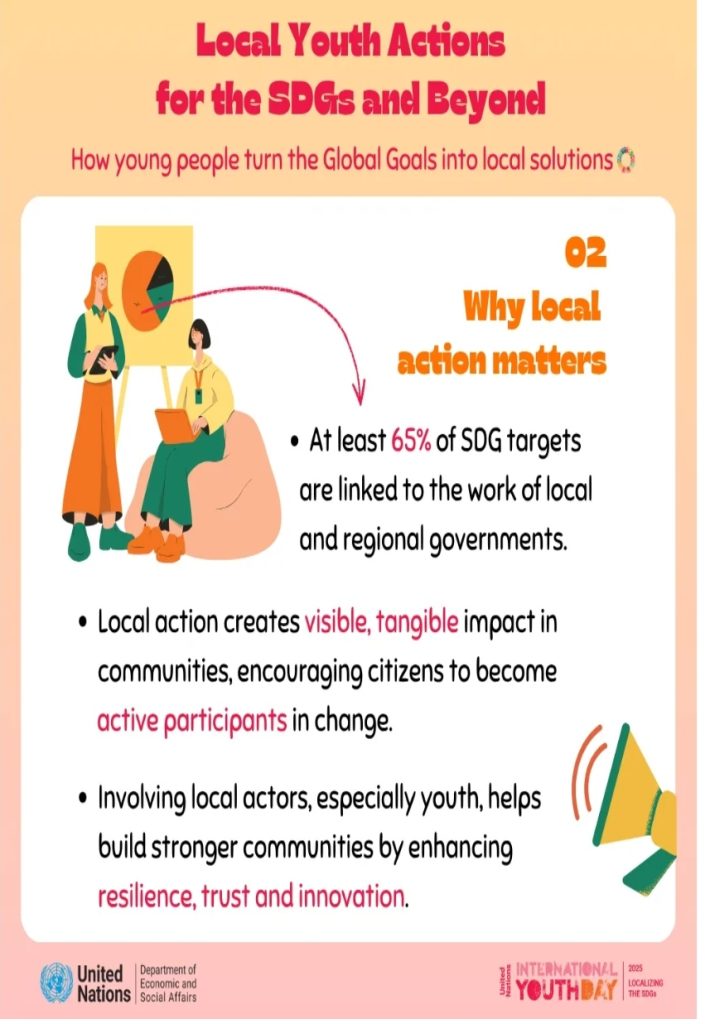
UN Platforms for Youth Engagement
The United Nations has built multiple avenues to amplify youth voices, including:
- The UN Youth Office, headed by the Assistant Secretary-General for Youth Affairs.
- The ECOSOC Youth Forum, which brings together over 1,000 youth leaders annually to engage directly with policymakers.
- The World Youth Report, a biennial publication that analyses global youth trends.
- Resolutions such as 2250 (2015), which position youth as key partners in peacebuilding, and 2535 (2020), which formalizes youth, peace, and security as a standing agenda.
These mechanisms ensure that young people are not simply participants but recognized decision-makers in global governance processes.
International Youth Day Infographic.
Explore these IYD infographics to learn what SDG localization means, why it matters, the role of youth in driving it, and how we can support their efforts.
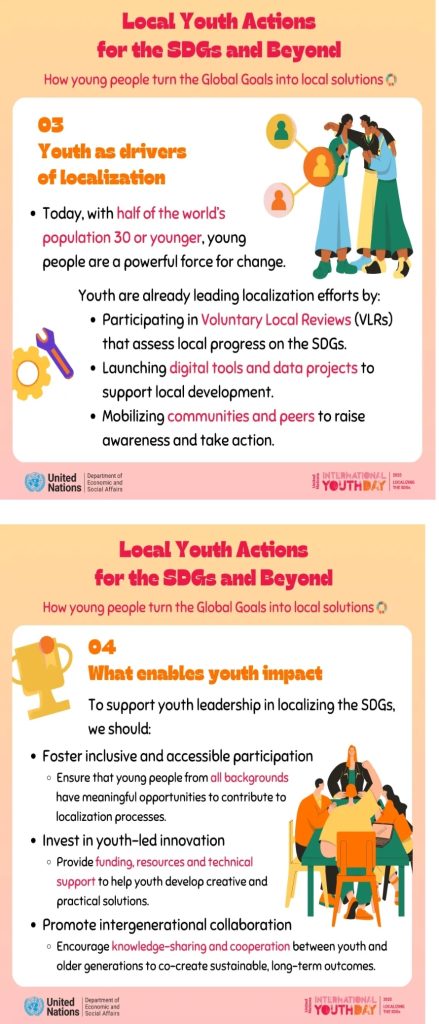
Written by Olivier Noudjalbaye Dedingar, USA/UN Correspondent.


